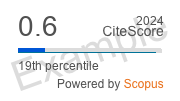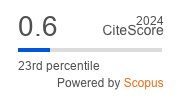INVOLVEMENT OF ENDOGENOUS OPIOID RECEPTOR AGONISTS IN INCREASING CARDIAC RESISTANCE TO THE DAMAGING EFFECTS OF REPERFUSION
https://doi.org/10.29001/2073-8552-2017-32-1-101-103
Abstract
It was found that an intravenous administration of the nonselective of opioid receptor (OR) antagonists naltrexone (5 mg/kg) and also the selective antagonist δ1-OR BNTX (0.7 mg/kg), the selective δ2-OR blocker naltriben (0.3 mg/kg), the κ-selective antagonist nor-binaltorphimine (2 mg/kg), do not affect cardiac reperfusion injury in vivo. It is established that the мselective antagonist CTAP limits infarct size.
About the Author
A. V. MukhomedzyanovRussian Federation
References
1. Лишманов Ю.Б., Маслов Л.Н., Наумова А.В., Богомаз С.А. Активация μопиатных рецепторов как фактор повышения устойчивости сердца к ишемическим и реперфузионным повреждениям // Рос. физиол. журн. – 1998. – Т. 84, № 11. – С. 1223– 1230.
2. Guo H.T., Zhang R.H., Zhang Y. et al. Endogenous κ-opioid peptide mediates the cardioprotection induced by ischemic postconditioning // J. Cardiovasc. Pharmacol. – 2011. – Vol. 58, No. 2. – P. 207–215.
3. Jang Y., Xi J., Wang H., Mueller R.A. et al. Postconditioning prevents reperfusion injury by activating δ-opioid receptors // Anesthesiology. – 2008. – Vol. 108, No. 2. – P. 243–250.
4. Ludvigsen E., Carlsson C., Tiensuu Janson E. et al. Somatostatin receptor 1-5; expression profiles during rat development // Ups. J. Med. Sci. – 2015. – Vol. 120, No. 3. – P. 157–168.
5. Maslov L.N., Khaliulin I., Oeltgen P.R. et al. Prospects of creation of cardioprotective and antiarrhythmic drugs based on opioid receptor agonists // Med. Res. Rev. – 2016. – Vol. 36, No. 5. – P. 871–923.
6. Maslov L.N., Lishmanov Yu.B., Oeltgen P.R. et al. Activation of peripheral δ2 opioid receptors increases cardiac tolerance to ischemia/reperfusion injury: Involvement of protein kinase C, NO-synthase, KATP channels and the autonomic nervous system // Life Sci. – 2009. – Vol. 84, No. 19–20. – P. 657–663.
7. Murphy D.B., Murphy M.B. Opioid antagonist modulation of ischaemia-induced ventricular arrhythmias: a peripheral mechanism // J. Cardiovasc. Pharmacol. – 1999. – Vol. 33, No. 1. – P. 122–125.
8. Neckar J., Szarszoi O., Herget J. et al. Cardioprotective effect of chronic hypoxia is blunted by concomitant hypercapnia // Physiol. Res. – 2003. – Vol. 52, No. 2. – P. 171–175.
9. Schultz J.E.J., Hsu A.K., Gross G.J.J. Ischemic preconditioning and morphine-induced cardioprotection involve the delta (δ)- opioid receptor in the intact rat hear // Mol. Cell. Cardiol. – 1997. – Vol. 29, No. 8. – P. 2187–2195.
10. Tsutsumi Y.M., Yokoyama T., Horikawa Y. et al. Reactive oxygen species trigger ischemic and pharmacological postconditioning: in vivo and in vitro characterization // Life Sci. – 2007. – Vol. 81, No. 15. – P. 1223–1227.
11. Ventura C., Bastagli L., Bernardi P. et al. Opioid receptors in rat cardiac sarcolemma: effect of phenylephrine and isoproterenol // Biochim. Biophys. Acta. – 1989. – Vol. 987, No. 1. – P. 69–74.
12. Yamada H., Nakamoto H., Suzuki Y. et al. Pharmacological profiles of a novel opioid receptor-like1 (ORL(1)) receptor antagonist, JTC-801 // Br. J. Pharmacol. – 2002. – Vol. 135, No. 2. – P. 323–332.
Review
For citations:
Mukhomedzyanov A.V. INVOLVEMENT OF ENDOGENOUS OPIOID RECEPTOR AGONISTS IN INCREASING CARDIAC RESISTANCE TO THE DAMAGING EFFECTS OF REPERFUSION. Siberian Journal of Clinical and Experimental Medicine. 2017;32(1):101-103. (In Russ.) https://doi.org/10.29001/2073-8552-2017-32-1-101-103




.png)





























